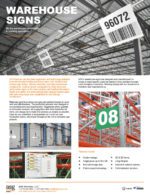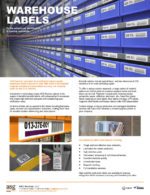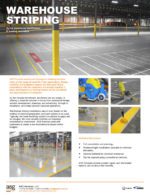It’s the work done before a product is called off that separates the amateur from the professional and why supply chains strive for the ‘next-best-thing’ which will give them the advantage. Here are some basic points we think you should consider when moving from a small warehouse, to a more robust environment, capable of handling the growth coming your way.
Choose a warehouse management system
Warehouse Management Software is not simply for stock taking, it can help optimize processes in your supply chain, movement of goods and pin point problem areas for improvement. In its most basic form, product names, SKU, description, quantity and location are key items to list, and you may currently use Excel to record and manage stock, which works great for many small firms, but as you grow it will become restrictive and limit your capabilities.
In migrating from a small storage scenario to a more formal setup, you’ll most likely have or are in the middle of selecting, your equipment. From the correct racking type for the weight of goods stored, to dock ramps which help you unload and load vehicles easier, material handling equipment is important for both operational and safety considerations. But these are all infrastructure, warehouse management software sits between that and the people who give the facility life.
WMS systems come in number of configurations, some developed for specific industries, others which are configurable and scalable as your company grows. At the ProMat trade show in Chicago and MODEX in Atlanta, there will be a great selection of companies providing these for you to speak to.
Plan your warehouse space
You must plan to maximize the storage space for every inch of your warehouse. It is a crucial warehouse management practice that does not cost much. The organization of an area is important to use every bit of space for storage and movement of goods, quick and safe. All the products should be accessible, so you do not have to move others to reach the intended. Take into consideration stock, office, storage, working areas, and empty pallet storage. Additionally, you must ensure that there is enough space for weight carrying machines and forklifts to move around.
If you need racks and shelves, consider the load capacity and build requirements. Professionally installed equipment from certified suppliers ensure a safer work environment and helps reduce future costs in upgrades and replacements. The Rack Manufacturers Institute (RMI) (http://www.rmiracksafety.org/) is a collection of companies who drive standards in the US. They would be a good starting point who will help you find a local distributor.
Implement a labeling convention
Street signs are used on roads, name plates on doors in buildings, and in warehouses, location labels are placed on racks and shelves which identify locations and save workers lots of time finding inventory needed
.Labeling and naming warehouse storage locations becomes increasingly important as stock variations and volumes increase, not to mention increases in the number of people working in your warehouse. Having a simple but effective method is therefore just as important as having the right forklift truck or wrapping machine.
If you haven’t yet, begin naming locations using the follow process. It’s a simple and very popular way of creating your first location name which can be applied to a rack label, floor label or hanging sign. If you follow this principle for the other locations and storage configurations, your reference file will take shape quickly as a virtual warehouse location system.
How to number a warehouse:
| 1. | Name the aisle | A |
| 2. | Name the bay | 001 |
| 3. | Name the level | 1 |
| 4. | Name the slot | A |
| 5. | Combine and segment | A 001 1A |
When added to an Excel document, the first three references may look like this:
| Aisle | Bay | Level | Slot | Visual | Barcode |
| A | 001 | 1 | A | A 001 1A | A0011A |
| A | 001 | 1 | B | A 001 1B | A0011B |
| A | 001 | 1 | C | A 001 1C | A0011C |
Label layouts could be as simple as handwritten entries on blank labels, or pre-printed location labels for a more professionally approach, which also help reduce vandalism with durable materials and protective coatings. See the design examples below. They use the same information in slightly different ways can help you maximize location identification considerably.
Which warehouse label should I use?
Handwritten:

In small storage facilities, handwritten labels are still the most cost-effective way to identify locations, but once you reach 50, you should really consider pre-printed. Handwriting 50 wouldn’t be so bad but imagine having someone write 100… not a quick task and mistakes would surely occur.
Pre-printed location labels:
Once you reach over 50 locations, its recommended that you print your rack and shelf labels, to save time and ensure content accuracy. You then have the option of more durable materials and designs, developed for the intended purpose. The following, are examples of pre-printed layouts using the same location reference, but with additional functionality to improve usability.
Standard location label:

Easier to read than handwritten labels with a uniform layout and more cost effective over 25 locations. You could create these in-house or use a specialist provider and benefit from durable material options.
Split base location label:

Save time and money with split base labels which combine two location references on to one layout. These could again be produced in-house, or by a supplier such as ASG Services. Applying one label per two locations also reduces installation time and costs significantly.
Barcode rack labels:
Linear Barcode

2D Barcode:

As your warehouse becomes more sophisticated, you may decide to utilize barcode technology. Linear barcodes are still the most popular choice, however 2D can offer a little more in terms of data held. If you have a fixed product location, you might use 2D to include more information about the product for better identification. Using suppliers for these types of location labels will be the smart way of equipping your rack and shelf edges.
Color coded pallet rack labels:

For faster identification of locations, color coding is recommended by the leading supplier who point out that people can identify objects faster through color differentiation. Consider giving each level a set color throughout your facility from floor storage, shelves, racks and even barcode handing signs. ASG Services also advise layout considerations to help reduce overall cost of products, installations and future operational efficiencies.
Using a digital system instead of a manual process to manage inventory is a must for any progressive firm. Manual systems reduce efficiency but also increase inaccurate inventory records. Even a basic system such as an Excel document is a must over paper based. However, a WMS or ERP is eventually where you should be heading, both of which will take care of inventory management and will help improve your accuracy tremendously.
Cycle counts
Count the items you store. It’s laborious and time consuming, but even with a full force WMS in the largest distribution facility, cycle counts are king. Physical counts of your inventory should not be an annual activity. Depending on the number of items stored per location and levels of stock movement will help determine their frequency. Daily, monthly or quarterly are not too frequent. If you don’t have it on the shelf, you lose business and profit. If you have too much on the shelf, you also lose too. Monitoring, recording and analyzing will help make your company more efficient.
Regular operational reviews
Review your warehouse operations all the time to improve your inventory control, from process flow to placement of equipment and viable safety policies. Verifying the maximum use of warehouse space and enhancing the productivity of your employees is also essential. Moreover, implementing strategies such as checking in with your organization and warehouse systems will help in the identification of any problems quickly. Remember those small inefficiencies could harm you in the long run if you do not address them soon.
Stock inventory as per demand
The demand of stock should dictate how you arrange your inventory. You should avoid hoarding excessive amounts of stock throughout the year if there is no regular demand for it. Small to medium sized firms typically sell their total stock holding 3-4 times per year,, therefore holding 1.5 times the average demand volume gives leeway should demand unexpectedly rise. An optimized inventory hold can greatly reduce the cost of storage, as you won’t have to pay for more space just to store surplus you don’t need.
Employee induction and training
Poorly trained employees could be one of the reasons why your warehouse management system may be failing to reach full potential. Your team needs to be aware of changes, so make sure everyone understands the inventory management practices and policies that you implement. you can’t organize your warehouse alone, so make sure your team are up to the job.
Hopefully, your efforts will see your company achieve aims, targets and growth, when ready, don’t spread yourself thin, speak to those companies at ProMat, Chicago like ASG Services, who can help dramatically improve your operation with the simplest of additions. ASG became a leading supplier because they are trusted by so many. They can even help when you chose the wrong supplier and often step in, to put right the mistakes of others. Inventory management is not as simple as it first seems, you will not be judged, instead, you will be taken care of.
Call us on +1 (877) 447-9798 to discuss you situation.
If you prefer to email, why not send all you can for us to provide the best response possible.
Buy items online and do it yourself with ASG Services off the shelf products.
Visit our online store
Our online store provides customers with the opportunity to purchase standardized products. The same technology, production and quality control methods are used, so you can be assured of their performance and durability.
Browse now






 Warehouse Signs
Warehouse Signs
 Warehouse Labels
Warehouse Labels
 ASG Installation Services
ASG Installation Services
 Warehouse Striping
Warehouse Striping
